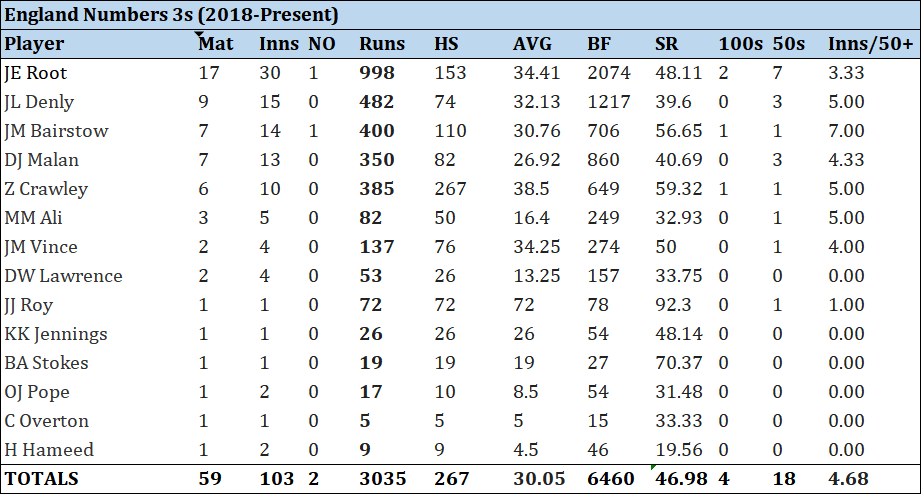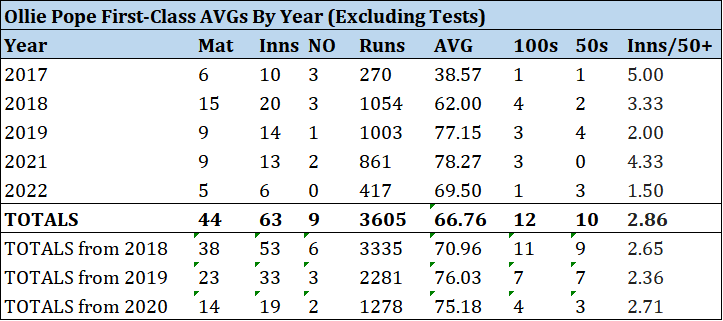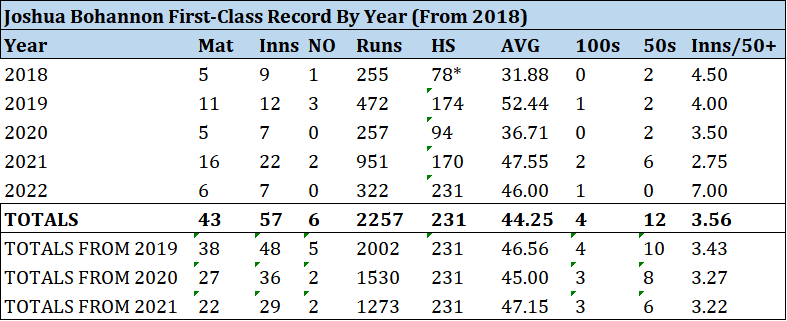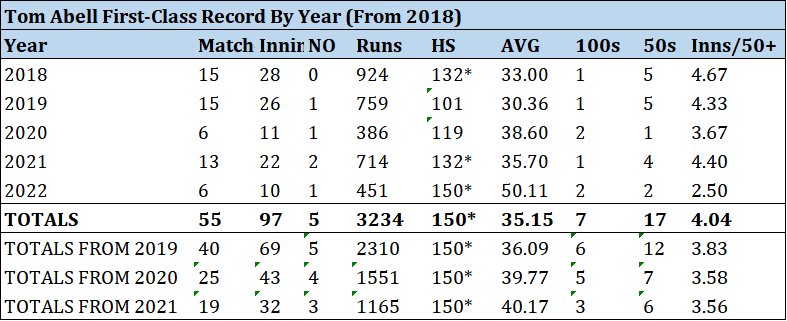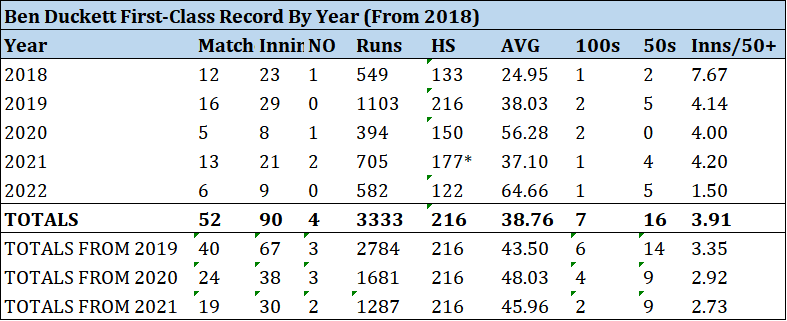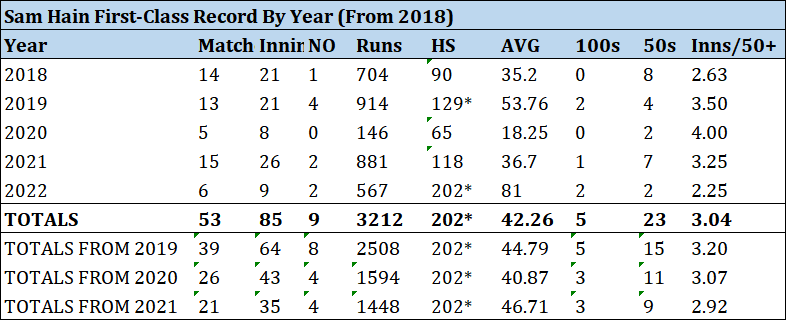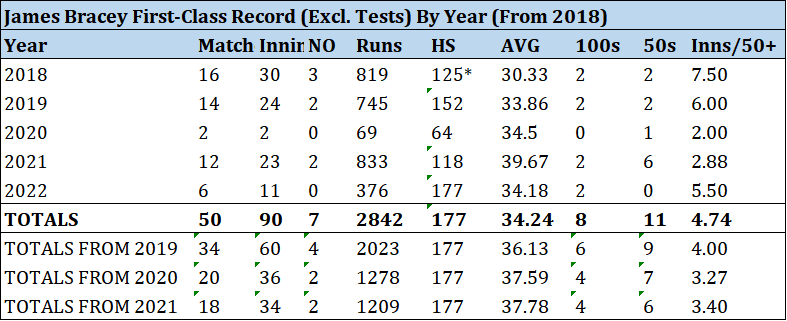State of the Squad: No. 3
England’s issues in the top order extend beyond the openers, with finding a good fit at three having proven to be similarly troublesome in recent years. Not since Jonathan Trott could England be said to have had a settled player there, and, with it one of the most important spots in the lineup, will be desperate for someone to make it their own as England look to rebuild in the coming months and years.
As with the opener spots, options for the position do exist in county cricket, but there are no real equivalents to Rory Burns or Dom Sibley in this case. Of the players who have batted there for England since the beginning of 2018, only Root has reached 20 innings and I think he is unlikely to bat there for any extended period going forwards.
Having always been quite vocal about his preference to bat at four, the fact that Root has batted more innings at three than anyone else, not only during the period spec’d here, but since the beginning of 2012 too, is further testament to the long-standing nature of the struggle. Joe Root is without doubt England’s best batter, but his splits make it very clear that he is indeed much better at four. I’d argue that to bat him at three would be to waste arguably the best batter in the world.
How much of the difference in production between the two positions lies in Root’s own psychology is difficult to ascertain, but it is possible that his own convictions have had an effect on his mindset at the crease. If he believes he is unable to bat there to his full potential, then he won’t.
Alternatively, the frequent failure of the opening batsmen have left him far more exposed there than he has been at four, although this is something which is true for everyone on the list above. It has perhaps been in an attempt to mitigate this that so many of those picked to bat at three in recent times have been players with experience opening, and not surprising that those players are amongst those who have had the most success there. Joe Denly, for example, who spent the first decade or so of his career as an opener, is arguably the second most successful of these players after Root. He did a pretty decent job for England overall too, and during his fifteen Test Matches also batted as an opener and at four, where he had his best spell, making three half-centuries against the Australians in 2019. More than half of his Test innings were at three however, from where he proved remarkably good at getting a start but not very good at getting big scores. In his fifteen innings there, he passed 50 three times without scoring a 100 and would get out between 20 and 49 nine times. His third lowest score was 18. In short, he should have got a lot more runs than he did. At 36, and with a First-Class average of only 21.47 since the beginning of 2021, his time has probably now passed.
Dawid Malan had the spot for all 5 matches in Australia over the winter, and despite two scores of 80+ in the first two Tests, his form dropped off and he hasn’t been selected in either of the two squads named since. Although he has scored well for Yorkshire in County cricket so far this year, he is approaching his 35th birthday, and is thus probably at the point in his career where a Test recall is unlikely, especially in a team focussed on rebuilding for the future. He is likely to retain his spot in the T20 squad, until at least the end of the World Cup, however, so we will see him batting at three for England again, just not in his whites.
Beyond these two, most of the players here were more or less shoe-horned into the last available spot in the lineup, with Root’s intent to bat at four meaning a series of unequipped players have been intermittently tasked with the role. Both Dan Lawrence and James Vince are prime examples of this, whilst Moeen Ali, who has batted at least 2 innings in every position in the lineup from 1 to 9, was always destined to be shunted there for a short spell on his trip up and down the order. With only optimism and a desire to appease their best batsmen seeming to be the logic behind many of these selections, it is not surprising that they did not work out when all are very clearly more suited to batting in the middle order.
The same applies to Jonny Bairstow, who was returned to the middle order subsequent to his own jaunt at three, and earned his spot at five for the first New Zealand Test following a good winter. With two failures at Lords, his spot for the second Test is up for grabs again, particularly with Harry Brook continuing his early season form into the T20 Blast. I do not think they will make the change, but a second poor Test for Bairstow may open the door for Brook.
Zack Crawley is another on the list above who is still in the squad, but he is currently (and misguidedly) in the team as an opener. Unlike Bairstow, he hasn’t come close to proving himself as an international cricketer. He needs to find a way to resist the urge to bring out those big, booming, drives early doors if he is to have any chance of making it as a top order batter, whether this be opening or at three. He needs to work out which of his feet is which. Part Two of this epic tale revealed much of what I think of him, so I’m not gonna go on and on about it, but his selection is an absolute travesty, wherever they put him down on the teamsheet.
For the New Zealand series, Ollie Pope has been the latest to be given the nod there, but his selection has been questioned. Not only has he never batted at three before, but he hasn’t yet managed to deliver on the potential suggested by his consistently obscene First-Class record at Test match level. Beyond a very good 2020, he has struggled for runs and, as the statlines below show, has had a particularly rough time in Test match cricket over the last year and a half or so, culminating in a disastrous Ashes tour this last winter. Few of his detractors’ doubts will have been eased by his efforts in the First Test at Lords.
The problem with leaving Pope out is the record detailed below.
These numbers are a bit silly, and suggest a man who could be amongst the world’s best players. He has been by far the most prolific English batter in county cricket over the last 5 years, and doesn’t seem to have ever lost form; even when struggling to average 20 in international cricket he has been knocking them out for Surrey at over 75 runs a go.
He kind of has to be selected as a result. There is nothing left for him to prove at county level, and has rightfully been given time to try and sort himself out for England. The question now is, should he really be being asked to do this at three, one of the most important positions in the lineup? Does his technical approach fit the role? Is he mentally equipped to bat there? Is he really going to be able to leave the ball as well as he will need to at Test Match level against Kyle Jamieson, Trent Boult and Tim Southee? Do they back him there primarily because he looks a bit like Ian Bell?
Who knows. I’d suggest however that he is simply the latest to have been shoehorned into the spot with nowhere else for him to slot into the lineup at the moment, and whilst I really hope he is given the chance to show that he can adapt and can score runs there, the jury is well and truly out on whether this is do-able. The issue is that all players run out of opportunities eventually, and if Pope is unable to capitalise on this chance, he runs the risk of being remembered in the same vein as players like Graeme Hick and Mark Ramprakash, terrific county players who were never able to convert their prolific First-Class returns into Test runs.
Without wishing to premeditate failure, the selectors will surely be looking to get someone in who has experience at three should Pope fail to deliver, and, whilst the options for this are not overly numerous, there are a few batters worthy of consideration at county level.
Perhaps the most notable of these is Lancashire’s Joshua Bohannon, who was the highest run-scorer in the First Division of last year’s County Championship. Indeed, he was so close to being picked for the West Indies series that a journalist mistakenly informed him that he had made the cut the night before the official squad announcement. He wasn’t in it, and subsequently hasn’t scored quite enough runs to have forced his way into the squad for the New Zealand series. Although he is averaging 46 this year, over two thirds of the 322 runs he has scored this year coming in a single innings of 231. At 25, however, he has a good future ahead of him and, if he is able to maintain a career average sitting just shy of 50, it is only a matter of time before he is given a chance at international level.
Somerset’s Tom Abell is noted foremost for his captaincy, but has also been a very consistent, if not prolific, run scorer since in recent years. He was mentioned as a left-field candidate for the England captaincy in some circles, with the more measured contingent of these maverick commentators suggesting that he might be worth assimilating into the side with an eye on him taking the job in the future. The days of Mike Brearley are gone, however, and it would need to be ensured that he is, first and foremost, able to contribute with the bat before this notion is pursued with any vigour. He has enjoyed a good start to the 2022 season and at 28 is entering what should be his peak years. I would put money on him playing international cricket at some stage, but probably wouldn’t even pop a free bet on him captaining the side just yet!
Off the back of two seasons (2015 an 2016) in which a combined 2340 runs and 9 centuries were scored, and still only 22, Ben Duckett looked like he was destined to be star when he was first selected for England in 2016. Initially an opener, his 7 innings at the top of England’s order were not hugely successful, however, and with a return of only 110 runs and only one half-century he was unable to lock down a place the side. He ha rebuilt his career and is these days a very decent, consistent, batter. Having also begun to bat at three for Nottinghamshire in the last few seasons, the runs he has scored of late will surely have put in the thoughts of the new selection committee when it is assembled. One thing they will be looking for him to improve is his conversion rate, as he has only gone on to pass 100 twice out of the eleven times he has reached 50 since the beginning of 2021.
As with Duckett, Hain is another player who was touted as a future Test player very early in his First Class career. He became Warwickshire’s youngest centurion when still 18, the first of four hundreds in a debut season which produced 823 runs at 51.43. A poor spell in 2016 and 2017 put a bit of dent in any international ambitions, but since 2018 his record has been pretty good. It would probably look much better had he managed to convert a few 50s into 100s in 2018 and then 2021, but his returns are decent enough even so and his form this year has been excellent, averaging 81 and reaching 200 for the first time.
One roadblock of note is that his only spell at three was 2020, although this was the shortened Covid season so is a small sample size. His career SR of 44% suggests a player with the temperament to bat there and it is possible we will see him there in the second half of the year. He will know that the spot is there for the taking in England’s lineup, so you would hope has been angling for it a go at it within the Warwickshire dressing room. Rob Yates, who has himself played for the Lions, has played all of their games at three so far this year, but hasn’t been able to follow up on an impressive 2021, managing only 133 runs across his 9 innings. If Hain could maintain his form with this hypothetical promotion, then he would became a real contender by the end of the year.
James Bracey’s brief foray into international cricket was not one he will look back on with any great fondness, with two ducks from his three innings leaving him with an average that only Chris Martin would be happy to trade for, 2.66. This is, of course, a sample size that means these numbers have very little weight or meaning, but he definitely has work to do if he is to be considered for selection going forward as a result.
Despite batting on a strip that has played like an M32 slip-road, and despite two centuries in the first two games of the season having set him up nicely for the year, he hasn’t gone on to score anywhere near the number of runs he would have liked so far in 2022. If he can find he form with which he began the year then he definitely has a chance of a call-up for the winter however, with his ability to bat in the top-order as a wicket-keeper very rare, and potentially valuable, in red-ball cricket. If Ben Foakes is unable to capitalise on his current opportunity in the long term, Bracey’s inclusion at three, a position in which he has batted for almost his entire First Class career, would open up a spot at seven for a player more suited than Foakes to the lower-middle order - Harry Brook is the obvious choice here, with his extremely high strike rate perfect for a position in which batting with the tail is often required. Bracey cause is aided further by his solid track record for the Lions, with a century against a good Australian bowling attack in December displaying his capabilities with the bat.
My verdict?
Pope will fail. Bohannon or Duckett next in line.


